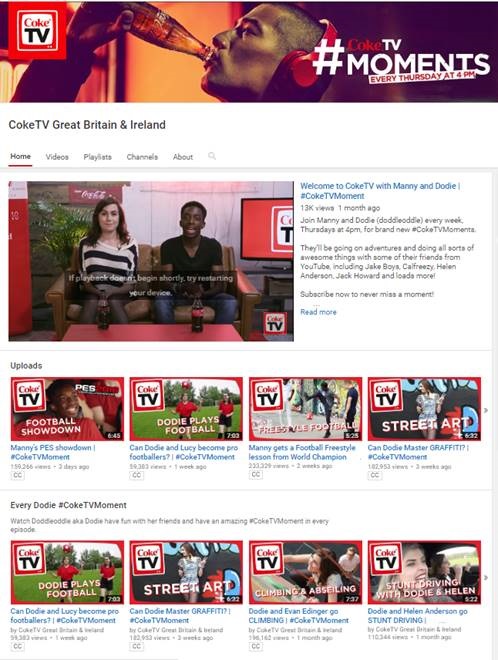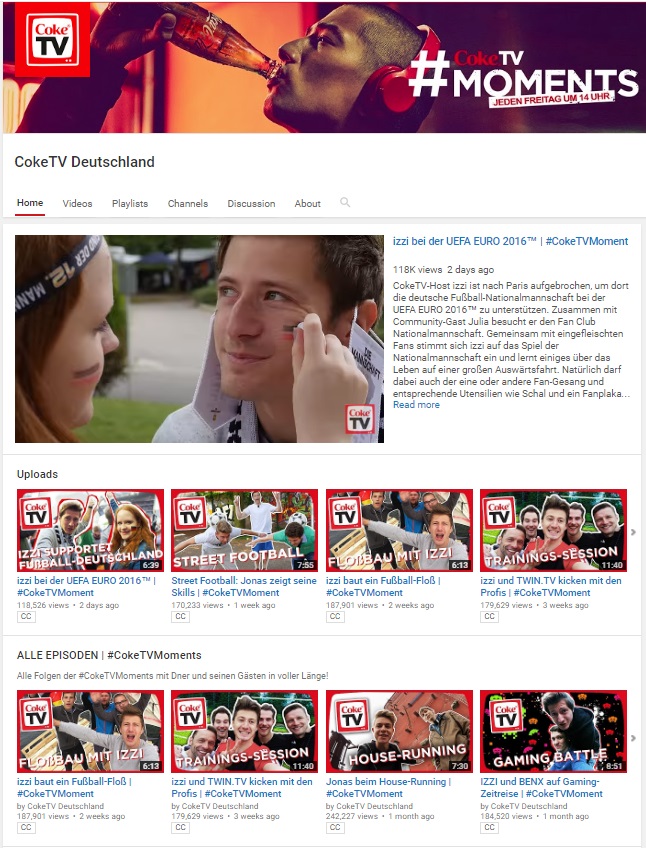Coca-Cola has created popular YouTube channels in Europe, working with popular YouTube vloggers to take its CokeTV channel to the UK, Germany, France and Spain as the FMCG giant ramps up its content marketing strategy as a new way to engage teens with authentic “eye-level” communication.
The soft drinks brand first launched CokeTV in Germany back in 2014, where it attracted over 268,000 subscribers and 29m views making it one of the most successful brand channels in the country.
The UK channel will be fronted by YouTube stars Manny and Dodie, with each episode focusing on entertainment 'passions' such as gaming, sports and music.
The hosts will recruit other vloggers to take on challengers and the show will also get exclusive access to events.
View the UK channel page below:

Speaking to Marketing Week, Bobby Brittain, marketing director for Coca-Cola Great Britain, said: “The beauty of CokeTV is it puts the Coca-Cola brand directly into the world of the YouTube generation, reflecting their interests and speaking their language, week after week.
It will be the most engaging platform to reach young adults in GB and Ireland, entertaining them with relevant and authentic content, uniquely served in a way only Coca-Cola can,” Brittain added.
View the German channel page below:

Brands becoming media owners
The move follows on from the huge success of Red Bull’s content marketing strategy.
Red Bull connected with its young audience by establishing itself as an enabler of thrill, sponsoring over 500 extreme sports, from base jumping, to snow sports, and even has its own Formula 1 team. Fans are kept up to date with all things extreme through a range of digital channels which even includes its own online TV channel – Red Bull TV.
Google recently claimed that YouTube delivers a 77% higher ROI than TV, with the research suggesting that brands should be spending anywhere between five to 25% of their ad budget on the channel.
Content marketing cut through
In today’s cluttered media landscape, brands are looking for ways to achieve cut-through. Many consumer packaged goods brands turn to content marketing approaches, as these deliver a range of benefits:
• Create seek-out experiences audiences want to engage with
• Provide always-on connections beyond the life of a campaign
• Deliver socially promoted messages among groups of friends, ensuring cut-through
• Boost the brand equity of the masterbrand
Repeat traffic
Coca-Cola has a strong history of successful content marketing. The Coke TV channel in Germany was the first in this recent wave of content marketing initiatives from the drinks manufacturer that has proven the approach for delivering vibrant and rich content to teens works well. Their content channels focus on entertainment and fun activities for teens, with YouTube presenters delivering eye-level experience that the brand is the sponsor and enabler of. There are channels also up and running in Spain and France.
“Coke TV is a great example of brands dealing with the new reality of teen engagement”, explains Danny Meadows-Klue, president of the Digital Training Academy. “Teens have been tuning out of advertising for a decade, and the smart brands – Nike, Axe, Coca-Cola, Red Bull – area switching to content marketing to earn the engagement of their audiences”.
“Paid media is still involved, but is used to promote the content, through highly targeted media buys that are both highly relevant to the audience and highly effective in their engagement.”
“Brand using this type of approach have an always-on media budget to fuel this type of content exposure and judge based on the view-through rate of the films, click-through rate to the assets, and the repeat traffic they get.”
Tips for content marketing
• Treat the content area as a strategic commitment for the brand, a key part of the marketing mix over a 2 year + cycle
• Allocate always-on marketing budgets to drive audiences, using the main platform (such as YouTube) as well as other relevant channels (typically programmatic, Facebook, and other social channels)
• Regularly review engagement metrics to identify what’s working best, and use this to refine the content plan